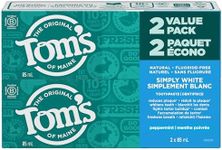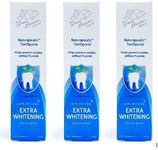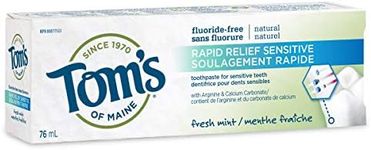Buying Guide for the Best Non Fluoride Toothpastes
Choosing a non-fluoride toothpaste can be a thoughtful decision, especially if you have specific health concerns, sensitivities, or personal preferences. When shopping for a non-fluoride toothpaste, it's important to look beyond just the absence of fluoride and consider other factors that contribute to oral health, such as cleaning ability, taste, and additional benefits. Understanding the key specifications will help you find a toothpaste that fits your needs and keeps your mouth feeling fresh and clean.AbrasivenessAbrasiveness refers to how much the toothpaste can scrub away plaque and stains from your teeth. This is important because a toothpaste that's too abrasive can wear down your enamel over time, while one that's too gentle might not clean effectively. Toothpastes are often rated on a scale called RDA (Relative Dentin Abrasivity). Low-abrasive toothpastes are suitable for people with sensitive teeth or enamel erosion, while medium levels are good for everyday cleaning. High-abrasive pastes are best for removing tough stains but should be used with caution. Think about your dental health—if you have sensitive teeth or thin enamel, go for a lower abrasiveness; if you want stain removal, a medium level may be right.
Cleaning AgentsCleaning agents are the ingredients that help remove food particles and plaque. In non-fluoride toothpastes, these can include baking soda, hydrated silica, or herbal extracts. The type and strength of cleaning agents affect how well the toothpaste cleans your teeth. If you prefer a more natural approach, look for toothpastes with plant-based or gentle cleaning agents. If you want a stronger clean, baking soda or silica-based options might be better. Your choice should depend on your preference for natural ingredients versus cleaning power.
Flavor and SweetenersFlavor and sweeteners make brushing more pleasant and can encourage regular use. Non-fluoride toothpastes often use natural flavors like mint, cinnamon, or fruit, and sweeteners such as xylitol or stevia. If you dislike strong mint or have allergies, look for milder or alternative flavors. If you want to avoid artificial sweeteners, check the ingredient list for natural options. Your taste preference and any sensitivities should guide your choice here.
Additional BenefitsSome non-fluoride toothpastes offer extra benefits like whitening, sensitivity relief, or breath freshening. Whitening toothpastes use gentle polishing agents, while sensitivity formulas may include ingredients to soothe nerves. If you have specific concerns like sensitive teeth or want a brighter smile, look for these added features. Choose a toothpaste that matches your main oral health goals.
Natural and Organic IngredientsMany non-fluoride toothpastes focus on natural or organic ingredients, avoiding synthetic chemicals, dyes, or preservatives. This is important if you have allergies, sensitivities, or prefer a more eco-friendly product. Toothpastes labeled as natural or organic often use plant extracts, essential oils, and mineral-based cleaners. If you value a clean ingredient list, check for certifications or read the label carefully to ensure it meets your standards.
Certifications and SafetyCertifications like cruelty-free, vegan, or organic can indicate that the toothpaste meets certain ethical or safety standards. This is important if you have specific lifestyle preferences or want assurance about product safety. Look for recognized certifications if these values matter to you, and always check that the toothpaste is approved for oral use by relevant health authorities.

















